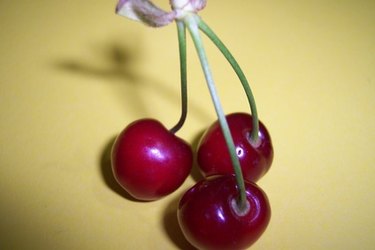Things You'll Need
Deep, rich soil
Compost
Wheelbarrow
Shovel
Fertilizer
Pheromone traps
Yellow sticky traps

Cherry trees fall into the category of stone fruits, which require a certain number of hours of cold weather in winter in order to set fruit. This is disappointing news for gardeners in southern California, Texas, Florida, Puerto Rico and Hawaii because the usual varieties of cherry trees will not produce fruit. However, some interesting varieties of cherries exist that are suited for warmer climates. They include the Surinam cherry, Brazilian cherry and Barbados cherry. Although these fruits are different from the typical Bing cherries grown in cooler areas, they might satisfy the cherry lover's craving.
Step 1
Select an area in full sun that has deep, well-draining soil for all three types of tropical cherry trees. Then dig a planting hole twice as large as the root system of your young cherry tree. Transfer the soil to a wheelbarrow.
Video of the Day
Step 2
Combine any type of organic compost into your planting hole at the ratio of one part compost to every four parts of soil. Adding compost to your planting hole will help to improve drainage and soil fertility.
Step 3
Backfill your planting hole about half full with your soil and compost mixture. Then unpot your young tree and set it in the hole, spreading its roots evenly around the hole. Fill the planting hole to the top with the remainder of your soil and compost combination.
Step 4
Water your newly planted cherry tree well after you plant it by running a sprinkler at its base for 20 to 30 minutes. In windward areas, which receive more rain than leeward areas, normal rainfall should be sufficient to keep your cherry tree watered. If you live in a leeward or other dry location, water your tree thoroughly once every two weeks, or when the soil is dry. A soaker hose or drip system is an efficient method of watering your tree.
Step 5
Fertilize one to four year old tropical cherry trees twice a year with ½ to 1 lb of a plant food having an N-P-K ratio of 8-8-13, according to Purdue University. After your tree is older than four years of age, increase this amount to 3 to 5 lbs of the same type of fertilizer.
Step 6
Control fruit flies with pheromone traps or yellow sticky traps hung from the branches when the tree is fruiting. Aphids and scale insects can also attack these types of tropical cherry trees. Spray with insecticidal soap or a horticultural oil to kill these destructive creatures. Some pests, such as caterpillars, can also attack these trees: Purdue University states that chemical products might be needed to control the Hesperid caterpillar and the aphid known as Aphis spiraecola.
Tip
All three of these tropical cherry trees can grow large: 20 to 35 feet is the expected adult height. Be sure to plant your tree where it will have plenty of room when it gets older; plant it away from any buildings and other large trees for best results. The botanical names for these cherries are as follows: Barbados cherry: Malpighia punicifolia; Surinam cherry: Eugenia uniflora; Brazilian cherry or Grumichama: Eugenia brasiliensis. The Brazilian cherry is slow-growing and might not produce fruit for its first seven years or longer.
Video of the Day